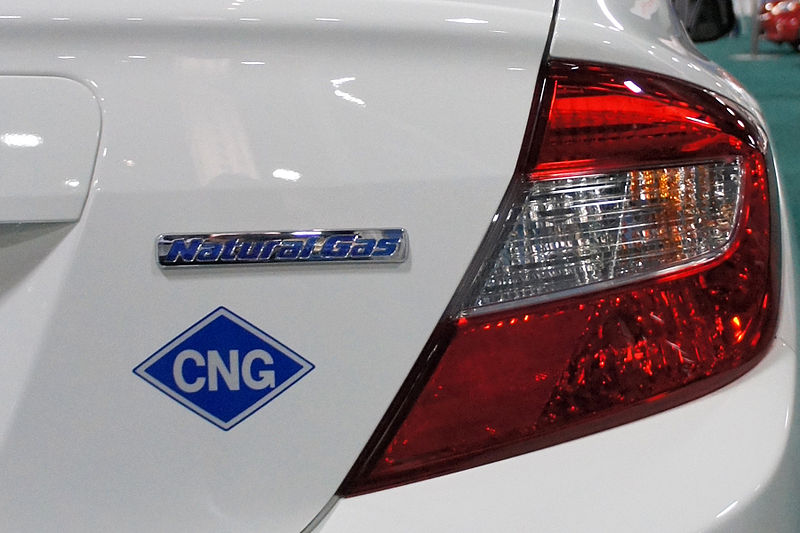
Wikipedia / MariordoHonda’s natural-gas-powered Civic.
Could the U.S. boom in natural gas lead to a boom in natural-gas cars? It can cost as little as $1 a gallon to fill them up in the U.S., says Bloomberg Businessweek, and there could be 25 million of them on roads worldwide by 2019.
To provide demand for a swelling supply of natural gas, the rush is on for investors, entrepreneurs, and the auto and energy industries to figure out how to power our transportation fleet with this abundant and relatively cleaner-burning fuel. Bloomberg reports:
Commercial vehicles, which generally rack up two or more times the annual mileage of consumer cars, are going first. In the last year many companies, including GE, UPS, FedEx, AT&T, PepsiCo, and Waste Management, the biggest trash hauler in the U.S., have announced plans to begin or expand conversions of their fleets to natural gas. Cities such as Los Angeles, New York, Phoenix, Fort Worth, Dallas, and San Francisco all have CNG [compressed natural gas] bus fleets. Large fleets of airport shuttles are converting as well.
According to the American Public Transit Association, nearly one-fifth of all transit buses were run by either CNG or LNG [liquefied natural gas] in 2011. Almost 40 percent of the nation’s trash trucks purchased in 2011 were natural gas-powered, the association said. Garret Alpers, founder and CEO of World CNG, a Seattle-based company that converts traditional gasoline cars into dual-fuel vehicles for as little as $8,000, estimates a taxi owner could recoup his expense in a year.
There are around 120,000 natural gas-powered vehicles on U.S. roads today, and over 1,000 natural-gas fueling stations (although only about half of those are open to the public). To encourage the fuel’s expansion from the commercial to the consumer realm, President Obama has advocated for the $7,500 tax credit for hybrids and plug-in vehicles to apply to natural gas-powered ones too, and in January he signed a bill extending a 50-cent-per-gallon tax credit for natural gas used in vehicles.
Brad Plumer says not to expect a natural-gas revolution on our roads anytime soon, though, pointing out that prices for natural gas-powered vehicles and conversions haven’t fallen enough yet:
The vehicles are still far pricier than gasoline-powered cars — or even hybrids. It can take between 13 and 20 years for drivers to recoup those savings in lower fuel costs. What’s more, fueling stations are hard to find.
Case in point: Honda has been selling a Civic that runs on compressed natural gas since 2008. So far, sales have been fairly torpid, with just 1,500 sold last year. Why is that? Well, for one, the price starts at $26,305, or about $8,000 more than a gasoline-powered Civic and $2,000 more than the hybrid version.
Plumer says this could change if oil keeps getting pricier and the technology surrounding natural-gas vehicles — manufacturing, building fueling stations, etc. — keeps getting cheaper. But, he wonders, …
… does it make sense to promote natural-gas vehicles at the expense of other technologies — like hybrids or plug-ins? [An] MIT report suggested that it might just be easier and more efficient to use America’s natural gas to power electric cars rather than set up an entirely new fueling infrastructure. And, so far, the country is nudging along in exactly that direction.
Indeed, Plumer notes, EV charging stations are proliferating much faster than natural-gas fueling stations, so it’s easier to fill up your car with electricity than natural gas. Bonus: EVs can also be charged with solar and wind power, so fracking is not necessarily required.




